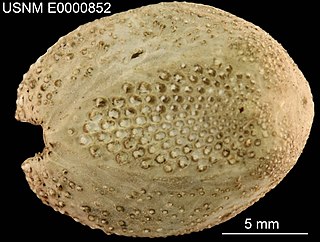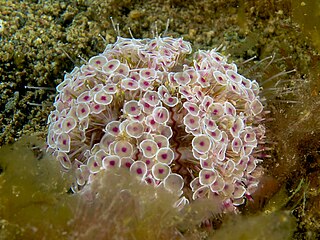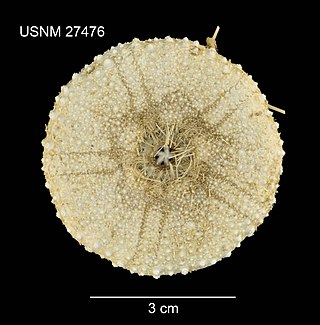
A pedicellaria is a small wrench- or claw-shaped appendage with movable jaws, called valves, commonly found on echinoderms, particularly in sea stars and sea urchins. Each pedicellaria is an effector organ with its own set of muscles, neuropils, and sensory receptors and is therefore capable of reflex responses to the environment. Pedicellariae are poorly understood but in some taxa, they are thought to keep the body surface clear of algae, encrusting organisms, and other debris in conjunction with the ciliated epidermis present in all echinoderms.

Toxopneustes pileolus, commonly known as the flower urchin, is a widespread and commonly encountered species of sea urchin from the Indo-West Pacific. It is considered highly dangerous, as it is capable of delivering extremely painful and medically significant stings when touched. It inhabits coral reefs, seagrass beds, and rocky or sandy environments at depths of up to 90 m (295 ft). It feeds on algae, bryozoans, and organic detritus.

Toxopneustidae is a family of globular sea urchins in the class Echinoidea.

Aceste ovata is a species of sea urchin of the family Schizasteridae. Their armour is covered with spines. It came from the genus Aceste and lives in the sea. Aceste ovata was first scientifically described in 1907 by Alexander Emanuel Agassiz & Hubert Lyman Clark.
Aporocidaris fragilis is a species of sea urchin of the family Ctenocidaridae. It is well-armoured with spines. It is placed in the genus Aporocidaris and lives in the sea. Aporocidaris fragilis was first scientifically described in 1907 by Alexander Emanuel Agassiz & Hubert Lyman Clark.
Araeosoma eurypatum is a species of sea urchin of the family Echinothuriidae. Its armour is covered with spines. It is placed in the genus Araeosoma and lives in the sea. A. eurypatum was first scientifically described in 1909 by Alexander Agassiz and Hubert Clark.

Araeosoma leptaleum is a species of sea urchin of the family Echinothuriidae. Its armour is covered with spines. It is placed in the genus Araeosoma and lives in the sea. A. leptaleum was first scientifically described in 1909 by Alexander Emanuel Agassiz & Hubert Lyman Clark.

Toxopneustes is a genus of sea urchins from the tropical Indo-Pacific. It contains four species. They are known to possess medically significant venom to humans on their pedicellariae. They are sometimes collectively known as flower urchins, after the most widespread and most commonly encountered species in the genus, the flower urchin.
Argopatagus planus is a species of sea urchin of the family Macropneustidae. Their armour is covered with spines. It is placed in the genus Argopatagus and lives in the sea. Argopatagus planus was first scientifically described in 1907 by Alexander Emanuel Agassiz and Hubert Lyman Clark, American scientists.
Caenopedina pulchella is a species of sea urchins of the family Pedinidae. Their armour is covered with spines. Caenopedina pulchella was first scientifically described in 1907 by Alexander Emanuel Agassiz and Hubert Lyman Clark.

Centrostephanus asteriscus is a species of sea urchin of the family Diadematidae. Their armour is covered with spines. Centrostephanus asteriscus was first scientifically described in 1907 by Alexander Emanuel Agassiz & Hubert Lyman Clark.

Chaetodiadema pallidum is a species of sea urchins of the Family Diadematidae. Their armour is covered with spines. Chaetodiadema pallidum was first scientifically described in 1907 by Alexander Emanuel Agassiz and Hubert Lyman Clark.

Chondrocidaris gigantea, also known as the rough-spined urchin or blade-tipped tiara-urchin, is a species of sea urchin of the family Cidaridae. Chondrocidaris gigantea was first scientifically described in 1863 by Alexander Agassiz.
Flower urchins may refer to:

Toxopneustes elegans is a species of sea urchin endemic to Japan. Like the closely related flower urchin, they are venomous.

Toxopneustes maculatus is a rare species of sea urchin found in the Indo-West Pacific.

Athanas areteformis is a species of small alpheid shrimp from the Indo-West Pacific.

Araeosoma is a genus of deep-sea sea urchins in the family Echinothuriidae.

Dermechinus is a genus of sea urchin in the family Echinidae found in deep water in the southern Indian, Pacific and Atlantic Oceans. It is monotypic, with Dermechinus horridus, sometimes called the cactus urchin, being the only species.

Mespilia globulus, the globular sea urchin, sphere sea urchin, or tuxedo urchin, is a sea urchin occurring in tropical shallow reef habitats. The specific name refers to a small ball or spherule, describing its overall shape/morphology. It is the only species in the genus Mespilia.
















